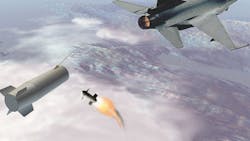Raytheon to demonstrate electronic warfare (EW) towed decoy aircraft protection from radar-guided missiles
PATUXENT RIVER NAS, Md. – Electronic warfare (EW) experts at the Raytheon Co. will demonstrate a new dual-band towed decoy to help U.S. Navy F/A-18E/F jet fighter-bomber pilots avoid modern sophisticated enemy radar-guided anti-aircraft missiles.
Officials of the U.S. Naval Air Systems Command at Patuxent River Naval Air Station, Md., announced a $32.9 million contract Thursday to the Raytheon Self Protect Systems segment in Goleta, Calif., to conduct a demonstration of existing technologies (DET) in support of the Dual Band Decoy (DBD) program to provide off-board countermeasures protection for the F/A-18E/F.
The DBD towed decoy project, launched one year ago, seeks to meet an urgent Navy need to protect crews of area-penetrating attack jets like the F/A-18E/F from enemy radar-guided missiles that operate on two separate frequencies, such as X-band and S-band.
Last month the Navy awarded a $36.7 million contract to the BAE Systems Electronic Systems segment in Nashua, N.H., to demonstrate DBD capability by capitalizing on existing systems or subsystems from other programs to reduce costs, schedule, and design risks.
From BAE Systems, Navy experts are most interested in the decoy's canister housing, decoy aerobody, internal electronics and antennas, towline cable, payout and brake mechanism, and connector and bulkhead interface assemblies.
Dual-band radar is particularly difficult to jam, and poses a serious threat to U.S. aircraft that must operate in contested airspace. A towed decoy trails behind the aircraft on a tether to draw the attention of enemy missiles and protect the aircraft from being hit.
This DET contract to Raytheon will demonstrate expanded capabilities of the Integrated Defensive Electronic Countermeasures AN/ALE-55 Fiber Optic Towed Decoy and AN/ALE-50 Advanced Airborne Expendable Decoy used on the F/A-18E/F aircraft.
The DBD program is intended as a replacement for the ALE-55 round assembly (T-1622/ALE-55(V)) and ALE-50 advanced airborne expendable decoy (AAED) (RT-1646E/ALE) deployed today onboard the F/A-18E/F to protect the aircraft from radar-guided missiles.
Navy experts want the DBD to meet or exceed all ALE-55 performance requirements, plus expanded RF requirements. BAE Systems engineers will design the system be compatible with all existing aircraft electrical interfaces on ALE-55 electronic frequency converter (EFC) (CV-4334/ALE-55(V)), ALE-50 integrated multi-platform launch controller (IMPLC) (CD-108B/ALE-50(V)), T-3F launcher (D-71/ALE-50A(V), and magazine (MX-12196/ALE-50A(V)).
Navy officials want the DBD round assembly to be compatible with the T-3F magazine and launcher, and want the DBD round assembly's mass to be as close as possible to the ALE-55 and ALE-50 round decoy assemblies.
For more information contact Raytheon Self Protect Systems online at www.raytheon.com, BAE Systems Electronic Systems at www.baesystems.com, or Naval Air Systems Command at www.navair.navy.mil.

John Keller | Editor-in-Chief
John Keller is the Editor-in-Chief, Military & Aerospace Electronics Magazine--provides extensive coverage and analysis of enabling electronics and optoelectronic technologies in military, space and commercial aviation applications. John has been a member of the Military & Aerospace Electronics staff since 1989 and chief editor since 1995.

